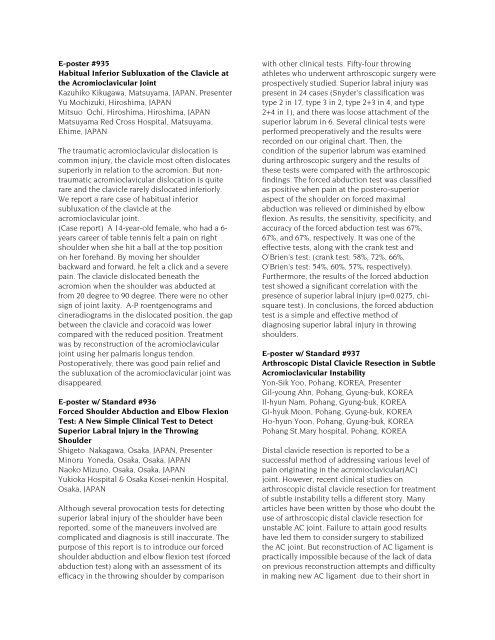POSTER ABSTRACTS - ISAKOS
POSTER ABSTRACTS - ISAKOS
POSTER ABSTRACTS - ISAKOS
You also want an ePaper? Increase the reach of your titles
YUMPU automatically turns print PDFs into web optimized ePapers that Google loves.
E-poster #935<br />
Habitual Inferior Subluxation of the Clavicle at<br />
the Acromioclavicular Joint<br />
Kazuhiko Kikugawa, Matsuyama, JAPAN, Presenter<br />
Yu Mochizuki, Hiroshima, JAPAN<br />
Mitsuo Ochi, Hiroshima, Hiroshima, JAPAN<br />
Matsuyama Red Cross Hospital, Matsuyama,<br />
Ehime, JAPAN<br />
The traumatic acromioclavicular dislocation is<br />
common injury, the clavicle most often dislocates<br />
superiorly in relation to the acromion. But nontraumatic<br />
acromioclavicular dislocation is quite<br />
rare and the clavicle rarely dislocated inferiorly.<br />
We report a rare case of habitual inferior<br />
subluxation of the clavicle at the<br />
acromioclavicular joint.<br />
(Case report) A 14-year-old female, who had a 6-<br />
years career of table tennis felt a pain on right<br />
shoulder when she hit a ball at the top position<br />
on her forehand. By moving her shoulder<br />
backward and forward, he felt a click and a severe<br />
pain. The clavicle dislocated beneath the<br />
acromion when the shoulder was abducted at<br />
from 20 degree to 90 degree. There were no other<br />
sign of joint laxity. A-P roentgenograms and<br />
cineradiograms in the dislocated position, the gap<br />
between the clavicle and coracoid was lower<br />
compared with the reduced position. Treatment<br />
was by reconstruction of the acromioclavicular<br />
joint using her palmaris longus tendon.<br />
Postoperatively, there was good pain relief and<br />
the subluxation of the acromioclavicular joint was<br />
disappeared.<br />
E-poster w/ Standard #936<br />
Forced Shoulder Abduction and Elbow Flexion<br />
Test: A New Simple Clinical Test to Detect<br />
Superior Labral Injury in the Throwing<br />
Shoulder<br />
Shigeto Nakagawa, Osaka, JAPAN, Presenter<br />
Minoru Yoneda, Osaka, Osaka, JAPAN<br />
Naoko Mizuno, Osaka, Osaka, JAPAN<br />
Yukioka Hospital & Osaka Kosei-nenkin Hospital,<br />
Osaka, JAPAN<br />
Although several provocation tests for detecting<br />
superior labral injury of the shoulder have been<br />
reported, some of the maneuvers involved are<br />
complicated and diagnosis is still inaccurate. The<br />
purpose of this report is to introduce our forced<br />
shoulder abduction and elbow flexion test (forced<br />
abduction test) along with an assessment of its<br />
efficacy in the throwing shoulder by comparison<br />
with other clinical tests. Fifty-four throwing<br />
athletes who underwent arthroscopic surgery were<br />
prospectively studied. Superior labral injury was<br />
present in 24 cases (Snyder's classification was<br />
type 2 in 17, type 3 in 2, type 2+3 in 4, and type<br />
2+4 in 1), and there was loose attachment of the<br />
superior labrum in 6. Several clinical tests were<br />
performed preoperatively and the results were<br />
recorded on our original chart. Then, the<br />
condition of the superior labrum was examined<br />
during arthroscopic surgery and the results of<br />
these tests were compared with the arthroscopic<br />
findings. The forced abduction test was classified<br />
as positive when pain at the postero-superior<br />
aspect of the shoulder on forced maximal<br />
abduction was relieved or diminished by elbow<br />
flexion. As results, the sensitivity, specificity, and<br />
accuracy of the forced abduction test was 67%,<br />
67%, and 67%, respectively. It was one of the<br />
effective tests, along with the crank test and<br />
O'Brien's test: (crank test: 58%, 72%, 66%,<br />
O'Brien's test: 54%, 60%, 57%, respectively).<br />
Furthermore, the results of the forced abduction<br />
test showed a significant correlation with the<br />
presence of superior labral injury (p=0.0275, chisquare<br />
test). In conclusions, the forced abduction<br />
test is a simple and effective method of<br />
diagnosing superior labral injury in throwing<br />
shoulders.<br />
E-poster w/ Standard #937<br />
Arthroscopic Distal Clavicle Resection in Subtle<br />
Acromioclavicular Instability<br />
Yon-Sik Yoo, Pohang, KOREA, Presenter<br />
Gil-young Ahn, Pohang, Gyung-buk, KOREA<br />
Il-hyun Nam, Pohang, Gyung-buk, KOREA<br />
Gi-hyuk Moon, Pohang, Gyung-buk, KOREA<br />
Ho-hyun Yoon, Pohang, Gyung-buk, KOREA<br />
Pohang St.Mary hospital, Pohang, KOREA<br />
Distal clavicle resection is reported to be a<br />
successful method of addressing various level of<br />
pain originating in the acromioclavicular(AC)<br />
joint. However, recent clinical studies on<br />
arthroscopic distal clavicle resection for treatment<br />
of subtle instability tells a different story. Many<br />
articles have been written by those who doubt the<br />
use of arthroscopic distal clavicle resection for<br />
unstable AC joint. Failure to attain good results<br />
have led them to consider surgery to stabilized<br />
the AC joint. But reconstruction of AC ligament is<br />
practically impossible because of the lack of data<br />
on previous reconstruction attempts and difficulty<br />
in making new AC ligament due to their short in
















